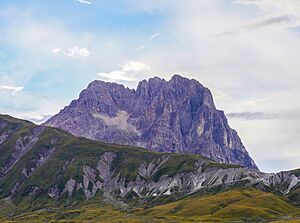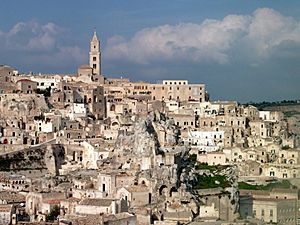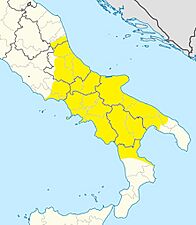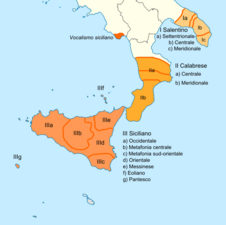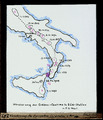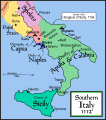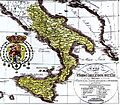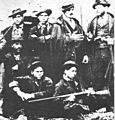Southern Italy facts for kids
Quick facts for kids
Southern Italy
|
|
|---|---|
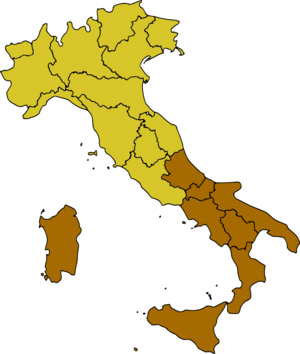 |
|
| Country | Italy |
| Regions | |
| Area | |
| • Total | 123,024 km2 (47,500 sq mi) |
| Population | |
| • Estimate
(2019)
|
20,637,360 |
| Languages | |
| – Official language | Italian |
| – Official linguistic minorities | |
| – Regional languages | |
Southern Italy is a large area in the southern part of Italy. It is also known as Mezzogiorno (pronounced Meh-zoh-JOR-noh), which means "midday" or "noon" in Italian. This name refers to how sunny and warm it is there.
This region includes several regions that were once part of the old Kingdom of Naples and Kingdom of Sicily. These two kingdoms later joined to become the Kingdom of the Two Sicilies. Even though the island of Sardinia was not part of these kingdoms, it is often included when people talk about Southern Italy for things like statistics and economy.
Contents
What is Southern Italy?
Southern Italy is a big part of the country. It includes the regions of Abruzzo, Apulia, Basilicata, Calabria, Campania, Molise, and Sicily. Sardinia is also often grouped with these regions, especially for statistics and economic reports.
Geography of Southern Italy
Southern Italy makes up the "boot" shape of the Italian Peninsula. It includes the "ankle" (Campania), the "toe" (Calabria), the "arch" (Basilicata), and the "heel" (Apulia). Molise is north of Apulia, and Abruzzo is north of Molise. The island of Sicily is separated from Calabria by the narrow Strait of Messina.
The Gulf of Taranto is between the "heel" and the "toe" of the boot. It is part of the Ionian Sea. To the east, you'll find the Adriatic Sea. On the west, there's the Tyrrhenian Sea with gulfs like Salerno and Naples. The beautiful Amalfi Coast is also here.
The weather in Southern Italy is mostly Mediterranean, meaning it has hot, dry summers and mild, wet winters. The biggest city is Naples. Other large cities include Bari, Taranto, Reggio Calabria, Foggia, and Salerno. This area can have earthquakes because it is geologically active.
History of Southern Italy
Southern Italy has a very long and interesting history, shaped by many different cultures.
Ancient Times: Greeks and Romans
Around 800-700 BCE, Greeks started to settle in Southern Italy and Sicily. They built many cities and brought their culture, language, and traditions. The Romans called this area Magna Graecia ("Great Greece") because there were so many Greek colonies.
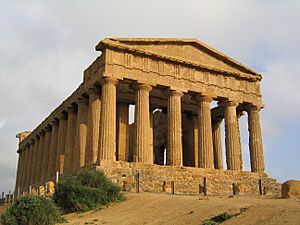
Some of these Greek cities became very rich and powerful, like Neapolis (Naples), Syrakousai (Syracuse), and Akragas (Agrigento). The Greek alphabet used here even influenced the Latin alphabet, which is used in many languages today.
Later, the Romans took control of Southern Italy. This region remained under Roman rule for a long time. After the Western Roman Empire fell, parts of Southern Italy were controlled by the Byzantine Empire (Eastern Roman Empire) for many centuries.
Middle Ages: Normans and Kingdoms
After the Romans, different groups fought for control of Southern Italy. In the 9th century, Lombards and Muslims also had influence. The Muslims even created an emirate on Sicily.

From the late 900s to the 1100s, the Normans (people from northern Europe) conquered all of Southern Italy and Sicily. They created the Kingdom of Sicily under Roger II. This kingdom was known for its good government and for being a place where Normans, Jews, Muslims, and Greeks lived together peacefully.
However, Norman rule ended in 1198. The Hohenstaufen family took over, and King Frederick II made many important laws for the kingdom. He also founded the University of Naples.
Later, the Kingdom of Sicily was split into two parts after a conflict called the Sicilian Vespers in 1282. One part was the island of Sicily, and the other was the mainland, which became known as the Kingdom of Naples. These two kingdoms remained separate for a long time, even when they were ruled by the same family.
Modern History: Spanish Rule and Unification
In 1442, Alfonso V from Spain conquered the Kingdom of Naples, bringing Sicily and Naples under Spanish control. Spain ruled Southern Italy for over 300 years, which had a big impact on its culture.
After the War of the Spanish Succession in the early 1700s, control of Southern Italy changed hands a few times, eventually going to a branch of the House of Bourbon family from Spain. These Bourbon kings ruled both Naples and Sicily.
Italian Unification
In the early 1800s, Napoleon took control of Naples for a short time. But after his defeat, the Bourbon kings returned. In 1816, the two kingdoms were officially reunited to form the Kingdom of the Two Sicilies.
However, this kingdom did not last long. In 1860, Giuseppe Garibaldi, a famous Italian leader, led an army called the "Expedition of the Thousand" to conquer Sicily and then the mainland. He was supported by the House of Savoy from northern Italy. The Kingdom of the Two Sicilies was defeated and became part of the new Kingdom of Italy in 1861.
After Unification: Challenges and Changes
When Italy became one country in 1861, there were big differences between the north and the south. Northern Italy had more roads, railways, and industries. Southern Italy had fewer of these things, and many people could not read or write.

Many people in the north thought Southern Italy was less developed. This led to a lot of challenges for the south. The economy struggled, and many people left Southern Italy to find work in other parts of Italy or in countries like the United States, South America, and Australia. This movement of people is called the Italian diaspora.
After World War II, there were efforts to help Southern Italy develop. However, even today, Southern Italy is generally less economically developed than the northern and central parts of the country.
Economy of Southern Italy
The economy of Southern Italy has faced challenges since Italy became a unified country.
Economic Differences
After 1861, the economy of the south struggled. Many farmers and small businesses found it hard to make a living because of new taxes and changes in trade rules. This led to many people choosing to move away.
In the 1950s, a big government plan called the Cassa per il Mezzogiorno was started to help industrialize the south. The idea was to create new farms and invest a lot of money to attract businesses and create jobs. However, these goals were not fully met.
Current Economic Situation
Today, there are still big economic differences between Southern Italy and the rest of the country. One of the main problems is that it's hard to attract new businesses and create enough jobs. Between 2007 and 2014, a large number of unemployed Italians were from the south.
Tourism is a very important part of the economy in Southern Italy. Its rich history and beautiful places attract many visitors. However, unemployment rates remain high, especially for women.
Some regions in Southern Italy are doing better than others. Abruzzo is currently the wealthiest region in the south, while Calabria has the lowest income per person.
| Rank | Region | 2017 | % of nationwide average |
|---|---|---|---|
| 12 | 25,000 | 86.51 | |
| 14 | 21,400 | 74.05 | |
| 15 | 20,900 | 72.32 | |
| 16 | 20,100 | 69.55 | |
| 17 | 18,700 | 64.71 | |
| 18 | 18,500 | 64.01 | |
| 19 | 17,700 | 61.25 | |
| 20 | 17,400 | 60.21 | |
| — | 28,900 | 100.00 |
Culture of Southern Italy
The culture of Southern Italy is unique because of its long history and the many different groups that have influenced it.
Cultural Influences
The ancient Greeks had a huge impact on the south, especially in Magna Graecia. Later, the Roman Empire brought Latin culture. During the Middle Ages, Sicily was also influenced by Muslims, bringing Arab culture to the island. The Byzantine Empire also left its mark, especially in religious practices.
The Normans also changed the architecture and culture when they arrived. Later, the long rule of Spain had a major influence on the south.
Jewish communities lived in Sicily and Southern Italy for over 1500 years, but they were forced to leave in 1492. Some converted to Christianity, while others moved to different parts of the world.
Famous Places and Traditions
Southern Italy has many amazing places to visit. These include the Palace of Caserta, the beautiful Amalfi Coast, the ancient ruins of Pompeii, the unique cave dwellings of Sassi di Matera, and the cone-shaped houses called Trulli di Alberobello. Many of these sites are protected by UNESCO.
You can also find ancient Greek cities like Sybaris and Paestum. The region also has several National Parks, like the Pollino National Park, which is the largest in Italy.
In recent years, there has been a renewed interest in the traditions and music of Southern Italy, such as the famous Neapolitan song and the lively tarantella dance.
- Linguistic borders of the Italo-Dalmatian southern Italian
Images for kids
-
Southern Italy during the time of Augustus.
-
The Kingdom of Sicily at its largest in the 12th century.
-
A 19th-century map of the Kingdom of the Two Sicilies.
See also
- National Institute of Statistics (Italy)
- NUTS statistical regions of Italy
- Italian NUTS level 1 regions:
- Northern Italy
- Central Italy
- Meridionalism
- Southern Italy autonomist movements


